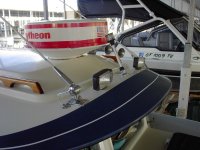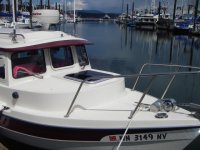Also doen't think the higher the db rating the better the antenna. Mostly they come in 3, 6, and 9 db. The antenna may be 8 ft physically, but electrically it is much shorter. Think of the radiation pattern as a donut shape radiating out horizontally in all directions. Each of the above antenna will be putting out pretty much the same amount of power. A 3 db would look like a fat donut with a fairly broad radiation from water level upwards sort of like if you shined a flood lamp out. As you narrow the beam (6db) you are focusing the radio signal and it will travel farther. As you focus the beam to a spotlight and the narrowest (3db) the signal (or the light beam in the flashlight travels farther. Think of the 3db as more of a dinner plate shape. So why would anyone not want the 9db? Because when you have a narrow radiation pattern emmitting from your fixed boat antenna and you are on the water with no rocking and rolling it is fine. However when you are underway and the boat is rolling the narrow beam is moving up and down pointing down into the water or up way over the horizon and any receiver that might be able to receive your signal.
This is why for most small boats you do not want a 9db. If you are on a large vessel it is no where near the problem.



